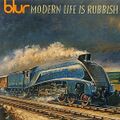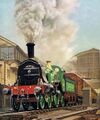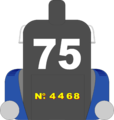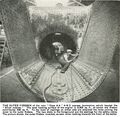Category:London and North Eastern Railway
| The "Big Four" railway companies |
|---|
 |
| Great Western Railway (GWR) |
| London, Midland and Scottish Railway (LMS) |
| London and North Eastern Railway (LNER) |
| Southern Railway (SR) |
1925: map of LNER routes including shipping [image info]
1925: LNER East Coast Route [image info]
1928: LNER container advert, with horse and cart [image info]
LNER: "Skegness is SO bracing" [image info]
The London and North Eastern Railway (LNER) was formed as part of the amalgamation of 1923, as the second largest of the Big Four companies. Based in King's Cross, it ran up the East Coast, serving Yorkshire, Northumbria and a large portion of Scotland.
Pre-1923 predecessors
- Great Northern Railway (GNR)
- North Eastern Railway (NER)
- Great Eastern Railway (GER)
- Great Central Railway (GCR)
- Hull and Barnsley Railway
- North British Railway (NBR)
- Great North of Scotland Railway
- Manchester, Sheffield and Lincolnshire Railway
- Midland and Great Northern Joint Railway
- Metropolitan Railway
1923 overview
The London and North Eastern Railway (see map), in extent the second largest of the four groups, possesses a distinctive character of its own, derived from that of its principal components. Of these the strongest was undoubtedly the North Eastern. Possessing a compact territory in which it had practically no competition, carrying a freight, and especially mineral, traffic of great value and intensity, it had long been conducted with conspicuous ability and enterprise, contracting practically no alliances and occupying financially a leading position among British railways. First acquiring the relatively small but strategically important Hull and Barnsley system, the North Eastern took the lead in the amalgamation negotiations for the group, as did the North Western in the other group. The other constituents in England were the three "Greats" — the Great Central, Great Eastern, and Great Northern — which before the war had already entered into a close working agreement. All three were trunk lines from London, the Great Central being the last to reach the metropolis, and only just beginning to reap the fruits of this somewhat costly development. The Great Eastern had very heavy suburban traffic and also served the agricultural and other industries and coast resorts of the Eastern counties. The Great Northern, besides tapping the principal industrial centres, formed the main portion of the East Coast route to Scotland. The East and West Coast routes respectively are now provided by the two premier groups. The Scottish constituents are the important North British system and the Great North of Scotland Railway. The Great Northern, North Eastern and North
British form a continuous main route through the industrial north to Scotland, carrying especially a dense iron, steel, coal and other heavy freight traffic, and the system has also the advantage of two other trunk routes via the Great Central and Great Eastern, There are also about 300 miles of canals. The total route mileage of line is about 6,600 miles.
The company claims to be the largest dock-owning railway in the world, possessing 38 docks with 38 miles of quays, largely equipped with the most modern shipping appliances. Among its more important docks and harbours are those of Grimsby, Harwich, Hull, Hartlepool, Immingham, Lowestoft, Methil, Middlesbrough, South Shields, and Sunderland. On the marine side of its undertaking, as the London Midland and Scottish concentrates on the Irish routes and certain river and lake traffic, so the London and North Eastern naturally devotes special attention to its Continental connections, running steamer services to Holland, Belgium, and Germany, via Harwich, Grimsby, Immingham, Hull and other ports. For this service it maintains six turbine vessels and 16 other large steamships, besides a number of smaller boats. The company also owns over a score of hotels.
The locomotive, carriage and wagon works of the system are at York, Darlington, Shildon, Doncaster, Gorton and Dukinfield (Manchester), Stratford, Cowlairs (Glasgow) and Inverurie. The North Eastern has long pursued a progressive policy in electrical operation and electrification.
The following leading statistics will compare with those given for the L.M. & S. Company.
The total capital of the company is about £350 millions. For 1921, the gross receipts from railway operation only were £90,000,000 ; the total expenditure on railway working, £78,500,000 ; and the net receipts, including all items, £14,500,000. The total passenger traffic for the year, apart from journeys represented by 227,000 season tickets, was 232,000,000. The freight traffic included general merchandise, 19,000,000 tons ; coal, coke and other fuel, 49,000,000 tons ; other minerals, 16,000,000 tons; and live stock, 6,200,000 . Proportionately, this will be seen to be heavier than the L.M. & S. figures, and a considerable share of it is contributed by the North Eastern traffic.The rolling-stock owned by the company includes 7,700 steam locomotives, 20,000 coaching vehicles, 297,000 freight vehicles and 16,500 service vehicles. There are also 140 electric motor and trailer coaches and 13 electric locomotives: others are being built. In 1921 the total engine-miles run, including shunting, were : steam, 132,000,000 miles ; electric, 879,000 miles.
The principal headquarters of the company are at Marylebone Station, London, and at York.
The locomotives
The LNER was known for its fast express thoroughbreds, and in obtaining Sir Nigel Gresley as Chief Mechanical Engineer from the Great Northern Railway. It also inherited the new A1 Pacific class. 4472 Flying Scotsman is the famous survivor of this type of express engine, and is perhaps the second locomotive in history to achieve a speed of 100 mph.
During the 1930s, Gresley designed a new class of streamlined Pacific called the A4. Designed to haul the Silver Jubilee service from King's Cross to Newcastle, the first of its kind, 2509 Silver Link, set a brief land speed record, and made the journey in the unprecedented 3 hours every day of its life. Some later A4s were painted in garter blue to haul the LNER's Coronation express train, which was known for its luxury "beaver tail" observation car at the rear of the train. It was in 1938 that the A4 4468 Mallard set a world speed record of 126 mph, which has never been beaten by a steam locomotive.
During the war, the quest for speed stopped, and the LNER found itself an occasional target of bombing raids. The A4 4469 Sir Ralph Wedgwood was infamously destroyed in an attack on the LNER shed in York, and the National Railway Museum is now built on the site of the tragedy.
Just before nationalisation, the LNER renumbered all its locos from 1 onwards. This led to some considerable difficulty for trainspotters when British Rail then added 60000 to every number, leaving every loco with an entirely different number to how they were remembered before the war!
After the end of steam, the LNER retained a special place in the hearts of enthusiasts. "Flying Scotsman" is regarded as the most famous locomotive in the world, and the NRM has devoted millions of pounds to bringing it back into steam for many years. Similarly, six of the A4 Pacifics were preserved all across the world, and in 2013 all of them were reunited in York in what was referred to as the Great Gathering. To commemorate this, Hornby released models of all the surviving locos shortly afterwards.
External links
- The LNER Society (lnersociety.org.uk)
- The London and North Eastern Railway (LNER) Encyclopedia (lner.info)
- LNER Coach Association (lnerca.org)
colours, designs and artwork:
Subcategories
This category has the following 10 subcategories, out of 10 total.
A
F
G
- Great Central Railway (4 P, 4 F)
L
- Locomotive 4498 Sir Nigel Gresley (2 P, 4 F)
N
- North Eastern Railway (6 P, 5 F)
S
T
- The Coronation (train) (2 P, 3 F)
- The Silver Jubilee (train) (6 P, 14 F)
Pages in category ‘London and North Eastern Railway’
The following 57 pages are in this category, out of 57 total.
B
C
F
- Facts about the LNER (Wonder Book of Railways 14th ed)
- Fish Van NE 168975 (Hornby Dublo D1)
- Flying Scotsman (Train Running Day)
- Flying Scotsman 4472 locomotive, steam-powered (Märklin)
- Flying Scotsman locomotive 4472 (2.5" gauge)
- Flying Scotsman locomotive biscuit tin LNER 4472 (Crawfords Biscuits)
- Flying Scotsman locomotive, gauge 0, BR 60103 (Corgi Bassett-Lowke)
- Flying Scotsman locomotive, gauge 0, LNER 4472 (Bassett-Lowke)
- Flying Scotsman No3 locomotive 4472 (Hornby Series)
- Flying Scotsman presentation set 4-344 (Trix Twin Railways)
G
L
- LMS 6999 U1-Class Beyer-Garratt locomotive (DJH, Peter G Wardle)
- LNER 33 Mogul locomotive (Bassett-Lowke gauge 1)
- LNER 4472 tender (Bowman Models 250)
- LNER 504 2-4-0 clockwork locomotive with tender (Bing Table Railway)
- LNER 504 2-4-0 clockwork tank locomotive (Bing Table Railway)
- LNER Express Parcels Service Van BB 1374 (Triang Minic 81M)
- LNER goods wagon (Bing Table Railway)
- LNER teak-effect coaches (Bing Table Railway)
- Locomotive LNER 0-4-0, No1 Tank Loco (Hornby Series)
- Locomotive LNER 2900, Tank Loco No1 (Hornby Series)
- Locomotive LNER 460, Tank Loco No2 (Hornby Series)
- Lumber Wagon No.1, L&NER (Hornby Series)
M
P
S
- Silver Jubilee streamlined train (Dinky Toys 16)
- Silver Jubilee train set No.0 (Hornby)
- Silver King locomotive LNER 2511 (Bassett-Lowke 4606)
- Silver King streamlined A4 locomotive 60016 (Hornby Dublo)
- Silver Link locomotive engineering drawings (Meccano Ltd.)
- Sir Nigel Gresley 4498 streamlined A4 locomotive, three-rail (Hornby Dublo D1)
- Spencer, Thomas and Friends Wooden Railway (Tomy)
- Steam powered 4-4-0 model locomotive (Bowman Models 234)
T
Media in category ‘London and North Eastern Railway’
The following 162 files are in this category, out of 162 total.
- 25 miles at 107 mph, Silver Jubilee train (RWW 1936).jpg 2,000 × 1,145; 609 KB
- A wash and brush up for The Flying Scotsman (WBoR 14ed).jpg 1,402 × 2,000; 900 KB
- A4 Gresley Streamliner, Lone Star Locos (LSLBroc).jpg 2,122 × 897; 602 KB
- Arsenal 2848 locomotive (Bassett-Lowke).jpg 1,200 × 900; 613 KB
- Balsa Raft,WW2, LNER (ICNBR 1945).jpg 2,000 × 1,371; 587 KB
- Bassett-Lowke advert Royal Scot Flying Scotsman.jpg 2,492 × 1,602; 334 KB
- Bassett-Lowke catalogue 1937-38 streamliners.jpg 1,280 × 960; 244 KB
- Bassett-Lowke Empire of India 4490, detail.jpg 1,024 × 768; 371 KB
- Bassett-Lowke Garden Railways, LNER Atlantic 9.5 gauge (BL-MR 1937-11).jpg 1,520 × 2,192; 607 KB
- Bassett-Lowke streamliners, Coronation, Coronation Scot, Silver Link (BLMR 1937-11).jpg 1,481 × 2,148; 550 KB
- Bassett-Lowke trains and boats (MM 1934-06).jpg 775 × 1,024; 162 KB
- Bassett-Lowke, Arsenal 2848, gauge 0 (BL-MR 1937-11).jpg 1,541 × 2,128; 513 KB
- Bassett-Lowke, Flying Scotsman, gauge 0 (BL-MR 1937-11).jpg 1,545 × 2,152; 562 KB
- Bassett-Lowke, Flying Scotsman, gauge 0 components (BL-MR 1937-11).jpg 2,544 × 1,644; 522 KB
- Bassett-Lowke, Flying Scotsman, gauge 0 components list (BL-MR 1937-11).jpg 1,597 × 2,485; 739 KB
- Bassett-Lowke, LMS LNER, 2-6-0, gauge 1 (BL-MR 1937-11).jpg 765 × 1,087; 246 KB
- Bassett-Lowke, LNER Mogul 33, gauge 1 (BL-MR 1937-11).jpg 1,525 × 1,159; 328 KB
- Bassett-Lowke, Silver Link, gauge 0 (BL-MR 1937-11).jpg 1,646 × 631; 121 KB
- Bassett-Lowke, Standard Tank loco 112, gauge 1 (BL-MR 1937-11).jpg 1,200 × 810; 216 KB
- Beginning the Run, Silver Jubilee train (RWW 1936).jpg 2,000 × 1,336; 753 KB
- Blur - Modern Life is Rubbish.jpg 300 × 300; 95 KB
- Bowman LNER 300, Black Cat Cigarettes (HW 1932-12-017).jpg 2,351 × 3,000; 2.09 MB
- Bowman Loco 234.jpg 1,086 × 672; 103 KB
- BR 60103 Flying Scotsman (BLCat0-00 1954).jpg 1,155 × 1,600; 419 KB
- Brake Van, LMS LNER, Märklin 2885-0 (MarklinCRH ~1925).jpg 1,340 × 1,065; 479 KB
- Closed Goods Van, Märklin E1929-0 (MarklinCRH ~1925).jpg 1,469 × 1,105; 558 KB
- Coal Truck, Märklin E1982-0 (MarklinCRH ~1925).jpg 1,443 × 955; 398 KB
- Cock O' The North locomotive (Märklin).jpg 640 × 480; 178 KB
- Cock O' The North Locomotive LNER 2001, Märklin L70-12920 (MarklinCat 1936).jpg 3,634 × 1,327; 2.09 MB
- Combination Train Set, Mettoy 5555 (MettoyCat 1940s).jpg 3,000 × 1,448; 613 KB
- Container with horse and wagon, LNER (TRM 1928-05).jpg 1,600 × 752; 350 KB
- Corridor Coach LNER, Hornby Dublo D1 (1938 Dublo brochure).jpg 801 × 387; 77 KB
- Corridor Coach LNER, Hornby Dublo D1 (HBoT 1939).jpg 887 × 466; 101 KB
- Express Passenger Train, Dinky Toys 798 (DinkyCat 1956-06).jpg 3,321 × 528; 398 KB
- Express Passenger Train, Dinky Toys 798 (DinkyCat 1957-08).jpg 3,000 × 647; 274 KB
- Flying Scotsman 4472 at signalbox, 00-gauge layout.jpg 3,200 × 2,134; 3.61 MB
- Flying Scotsman 4472 at signalbox, low angle.jpg 3,200 × 2,134; 3.54 MB
- Flying Scotsman advert, 1924.jpg 1,511 × 2,000; 605 KB
- Flying Scotsman BR 60103 (BLCat 1952-autumn).jpg 3,000 × 1,987; 1.26 MB
- Flying Scotsman corridor tender, cab view (TRM 1928-05).jpg 999 × 1,200; 329 KB
- Flying Scotsman corridor tender, rear view (TRM 1928-05).jpg 1,171 × 2,000; 896 KB
- Flying Scotsman corridor tender, through view (TRM 1928-05).jpg 908 × 1,800; 588 KB
- Flying Scotsman LNER 4472 (WBoR 14ed).jpg 2,500 × 1,959; 1.16 MB
- Flying Scotsman LNER 4472 biscuit tin, Crawfords, detail.jpg 2,500 × 1,409; 1.73 MB
- Flying Scotsman LNER 4472 biscuit tin, Crawfords, tender detail.jpg 2,500 × 1,667; 2.14 MB
- Flying Scotsman LNER 4472 with new tender (TRM 1928-05).jpg 4,337 × 1,265; 1.13 MB
- Flying Scotsman locomotive, card model (Trix1800 SC3).jpg 1,585 × 764; 560 KB
- Flying Scotsman locomotive, cross-section (WBoR 14ed).jpg 3,000 × 1,855; 2.33 MB
- Flying Scotsman nameplate artwork.jpg 1,200 × 459; 68 KB
- Flying Scotsman non-stop service (TRM 1928-05).jpg 777 × 1,200; 295 KB
- Flying Scotsman Stirling Single No.1, M. Secretan, small.jpg 503 × 603; 63 KB
- Flying Scotsman Train Running Day (2015).png 1,920 × 1,081; 219 KB
- Flying Scotsman Train Running Day, BTMM October 2015.jpg 2,500 × 1,407; 1.82 MB
- Flying Scotsman with bus.jpg 1,600 × 900; 965 KB
- Flying Scotsman, article (MM 1928-04).jpg 1,200 × 798; 600 KB
- Flying Scotsman, F Moore (TRM 1929-01).jpg 3,000 × 2,273; 4.81 MB
- Golden Fleece loco BR 60030, Hornby Dublo 2211 (HDBoT 1959).jpg 2,200 × 1,381; 301 KB
- Golden Fleece locomotive 60030, Hornby Dublo 2211 (DubloCat 1963).jpg 2,420 × 893; 363 KB
- Goods Brake Van LNER, Hornby Dublo D1 (HBoT 1939).jpg 583 × 503; 69 KB
- Goods Container, LNER BLS 297, Hornby Series (MM 1936-09).jpg 757 × 696; 134 KB
- Goods Van 12-Ton LNER, Hornby Dublo D1 (DubloBrochure 1938).jpg 507 × 545; 81 KB
- Goods Van 12-Ton LNER, Hornby Dublo D1 (HBoT 1939).jpg 571 × 533; 70 KB
- Gresley Coach Brake 3rd, card kit, bagged (TrixTrains C2).jpg 1,322 × 2,000; 2.07 MB
- Hamblings catalogue 1938, front cover (HamblingsCat 1938).jpg 1,345 × 2,000; 983 KB
- High-Capacity Wagon, Hornby Dublo D1 (HBoT 1939).jpg 878 × 464; 104 KB
- High-Sided Wagon LNER, Hornby Dublo D2 (HBoT 1939).jpg 570 × 467; 70 KB
- Hornby Brake Van LNER (1925 HBoT).jpg 737 × 682; 70 KB
- Hornby Breakdown Van and Crane LMS-LNER (1925 HBoT).jpg 1,003 × 705; 102 KB
- Hornby Dublo LNER Silver King A4 locomotive 60016 detail.jpg 800 × 600; 236 KB
- Hornby E320 Locomotive, LNER 4472 Flying Scotsman (HBoT 1934).jpg 2,001 × 1,293; 396 KB
- Hornby Gunpowder Van LMS LNER (1925 HBoT).jpg 768 × 692; 68 KB
- Hornby M0 Locomotive 4472 (HBoT 1930).jpg 2,824 × 1,481; 539 KB
- Hornby No.0 Goods Set, LNER (1925 HBoT).jpg 2,000 × 800; 346 KB
- Hornby No.0 Passenger Set, LNER (1925 HBoT).jpg 2,000 × 800; 352 KB
- Hornby No.1 Cattle Truck LMS LNER (1925 HBoT).jpg 900 × 600; 76 KB
- Hornby No.1 Goods Set, LNER (1925 HBoT).jpg 1,868 × 771; 211 KB
- Hornby No.1 Passenger Set, LNER (1925 HBoT).jpg 2,850 × 942; 535 KB
- Hornby No.1 Tank Goods Set, LNER (1925 HBoT).jpg 1,509 × 486; 132 KB
- Hornby No.1 Tank Loco, LNER (1925 HBoT).jpg 950 × 750; 103 KB
- Hornby No.1 Timber Wagon (1925 HBoT).jpg 840 × 500; 54 KB
- Hornby No.2 Cattle Truck (1926 HBoT).jpg 889 × 589; 100 KB
- Hornby No.2 Goods Set, LNER (1925 HBoT).jpg 3,200 × 1,024; 380 KB
- Hornby No.2 Tank Goods Set, LNER (1925 HBoT).jpg 1,968 × 574; 182 KB
- Hornby No.2 Tank Loco, LNER (1925 HBoT).jpg 1,450 × 800; 146 KB
- Hornby No.2 Tank Passenger Set, LNER (1925 HBoT).jpg 1,515 × 435; 123 KB
- Hornby No1 Locomotive LNER 5097 (HBoT 1930).jpg 1,031 × 527; 93 KB
- Hornby No2 Pullman Set, LNER (1926 HBoT).jpg 2,037 × 624; 180 KB
- Hornby No2 Special Locomotive and Tender LNER 234 Yorkshire (HBoT 1929).jpg 1,419 × 471; 128 KB
- Hornby No2 Special Locomotive, LNER 234 Yorkshire, detail.jpg 1,024 × 768; 378 KB
- Hornby No2 Special Tank Locomotive LNER 6 (HBoT 1929).jpg 3,156 × 2,241; 759 KB
- Hornby Railways catalogue, front cover (HRCat 1979).jpg 2,400 × 1,679; 1.04 MB
- Hornby Silver Jubilee Train Set (1939 HBot).jpg 3,270 × 1,232; 633 KB
- Hornby Silver Jubilee train set No.0 (1939-).jpg 2,397 × 819; 404 KB
- Hornby Snow Plough (1925 HBoT).jpg 712 × 723; 77 KB
- Hornby Trains, Flying Scotsman 4472 box artwork, rectangular sticker (Meccano Ltd).jpg 2,400 × 1,798; 3.02 MB
- Hornby Trains, Flying Scotsman 4472 box artwork, round sticker (Meccano Ltd).jpg 2,400 × 1,796; 3.5 MB
- Hornby Trolley Wagon (1925 HBoT).jpg 900 × 580; 69 KB
- Hornby-Dublo box lid artwork, 1938.jpg 800 × 260; 133 KB
- LNER 33 Mogul locomotive (Bassett-Lowke, gauge 1).jpg 800 × 450; 258 KB
- LNER 4-4-0 locomotive 4-536 (TTRcat 1939).jpg 1,600 × 566; 191 KB
- LNER Gresley Coaches, card models (TrixTrains C1 C2 C3).jpg 2,400 × 961; 1.02 MB
- LNER locomotive 2838 Melton Hall (Bassett-Lowke).jpg 2,500 × 1,667; 1.98 MB
- LNER Passenger Coach 11652, Bowman Models 551 (BowmanCat ~1931).jpg 2,903 × 1,985; 1.65 MB
- LNER route map (TRM 1925-01).jpg 1,668 × 2,500; 1.2 MB
- LNER Standard Wooden Coaches (Milbro 1930).jpg 2,595 × 1,510; 458 KB
- Locomotive 294 2-4-0, LMS LNER, Märklin E1030 (MarklinCRH ~1925).jpg 2,659 × 1,231; 1,008 KB
- Locomotive LNER 4472 Flying Scotsman, gauge 0 (Bassett-Lowke).jpg 1,024 × 768; 414 KB
- London and North Eastern Railway, East Coast Route (TRM 1925-09).jpg 2,000 × 1,595; 547 KB
- Mallard A4 locomotive LNER 4468 (NRM 2018-04-29).jpg 2,000 × 1,500; 858 KB
- Mallard loco, Museum of British Transport, Clapham (MM 1964-12).jpg 2,200 × 1,482; 453 KB
- Mallard locomotive, LNER A4, card model (Trix1800 SC2).jpg 1,594 × 713; 498 KB
- Mallard75.png 1,886 × 1,978; 161 KB
- Model Locomotive Building, Bassett-Lowke.jpg 1,600 × 534; 251 KB
- Märklin Safety Railway (HW 1930-12-06).jpg 3,200 × 1,232; 1.07 MB
- New Pullman Services, LNER (TRM 1928-05).jpg 830 × 1,200; 263 KB
- Open Goods Truck, fixed sides, LMS LNER, Märklin 2881-0 (MarklinCRH ~1925).jpg 1,381 × 1,033; 474 KB
- Open Goods Truck, Märklin E1916-0 (MarklinCRH ~1925).jpg 1,217 × 950; 450 KB
- Open Goods Truck, with hinged door, Märklin E1962-0 (MarklinCRH ~1925).jpg 1,182 × 937; 362 KB
- Open Goods Wagon 12-Ton LNER, Hornby Dublo D1 (HBoT 1939).jpg 577 × 491; 62 KB
- Open-Sided Fruit Waggon, Märklin E1965-0 (MarklinCRH ~1925).jpg 1,219 × 1,119; 460 KB
- Outer Firebox, Silver Jubilee train (RWW 1936).jpg 2,000 × 1,949; 1.05 MB
- Over 70 mph, Silver Jubilee train (RWW 1936).jpg 1,571 × 2,000; 989 KB
- Passenger Coach, LNER, Märklin 2871-0 (MarklinCRH ~1925).jpg 1,381 × 1,237; 555 KB
- Passenger Coach, LNER, Märklin 2873-0 (MarklinCRH ~1925).jpg 1,696 × 1,227; 725 KB
- Passenger Coach, LNER, Märklin 2875-0 (MarklinCRH ~1925).jpg 2,337 × 1,238; 1,013 KB
- Silver Jubilee Poster.jpg 426 × 643; 76 KB
- Silver King Locomotive BR 60016, Hornby Dublo EDL11 (~1956 catalogue).jpg 2,389 × 821; 306 KB
- Silver King locomotive LNER 2511 (Bassett-Lowke 4606).jpg 3,000 × 748; 363 KB
- Silver Link head-on, Silver Jubilee train (RWW 1936).jpg 1,369 × 2,000; 611 KB
- Silver Link LNER 2509, Bassett-Lowke, Get Model-Minded (MM 1936-10).jpg 2,200 × 1,392; 658 KB
- Silver Link, Silver Jubilee train (RWW 1936).jpg 1,564 × 2,000; 769 KB
- Sir Nigel Gresley locomotive LNER 4498, Hornby Dublo EDP1 (1938 brochure).jpg 2,242 × 884; 510 KB
- Skegness is so Bracing, LNER, tinplate sign (1930s).jpg 859 × 1,369; 400 KB
- Special Coaches, Silver Jubilee train (RWW 1936).jpg 2,000 × 1,518; 762 KB
- Steam 0-4-0 Tank Locomotive, Bowman Models 265 (BowmanCat ~1931).jpg 3,000 × 2,246; 2.27 MB
- Steam 4-4-0 Express Locomotive, Bowman Models 234 (BowmanCat ~1931).jpg 3,000 × 2,311; 2.92 MB
- Streamlined Passenger Train Set, Hornby Dublo EDP1 - DP1 (1939 HBot).jpg 2,703 × 1,863; 525 KB
- Streamlined Train Set, Dinky Toys 16 (MCat 1939).jpg 2,740 × 561; 159 KB
- Ten Ton Open Truck, LMS LNER, Märklin 1981-0 (MarklinCRH ~1925).jpg 1,446 × 916; 445 KB
- The Coronation, booklet, carriage layout diagram (LNER 1937).jpg 3,000 × 2,326; 3.4 MB
- The Coronation, booklet, cover (LNER 1937).jpg 3,000 × 2,291; 2.12 MB
- The Flying Scotsman 1862-1962, portrait of a train, by Hamilton Ellis.jpg 790 × 1,200; 330 KB
- The Flying Scotsman, Bob Gwynne, 0747807701 (Shire Library).jpg 848 × 1,200; 168 KB
- The Flying Scotsman, times, LNER (TRM 1928-05).jpg 835 × 1,200; 201 KB
- The Silver Jubilee booklet, cover (LNER 1935).jpg 3,000 × 2,003; 4.45 MB
- The Silver Jubilee, booklet, carriage layout diagram (LNER 1935).jpg 3,000 × 2,029; 2.67 MB
- The Wonder Book of Railways, 14th edition, cover.jpg 921 × 1,200; 322 KB
- Three New Hornby Trains, Hornby No.3 locomotives (MM 1927-12).jpg 929 × 1,200; 527 KB
- Track layout, British Empire Exhibition (MRN 1938-09).jpg 1,800 × 1,215; 486 KB
- Tri-ang Hornby Book of Trains, cover.jpg 1,543 × 2,200; 697 KB
- Two-Coach Articulated Unit LNER, Hornby Dublo D2 (HBoT 1939).jpg 1,490 × 499; 170 KB
- Two-Coach Articulated Unit, Hornby Dublo D2 (1938 Dublo brochure).jpg 1,149 × 389; 125 KB
- Use LNER Containers (TRM 1928-05).jpg 1,095 × 1,600; 388 KB
- Vegetable Waggon, Märklin E1969-0 (MarklinCRH ~1925).jpg 1,214 × 1,041; 461 KB
- Wells-Brimtoy, Golden Eagle 4482 (GaT 1939).jpg 1,145 × 1,492; 263 KB
- Wikimedia Flying Scotsman photograph (F R Hebron).jpg 854 × 464; 96 KB
- Yorkshire locomotive LNER 234 (WBoR 14ed).jpg 1,600 × 707; 351 KB









































































































































